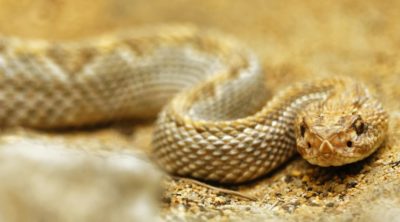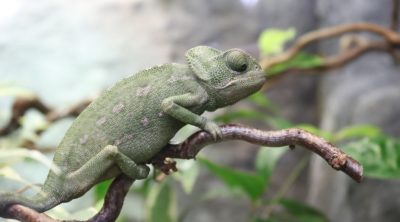
Tegus are large lizards, mainly found in South America. They can be as much as 1.23 m in length and weigh up to 15 lb. PetPonder brings you some fascinating facts about these reptiles.
Did You Know?
The tegu uses its tongue to pick up chemicals in the air. The Jacobson’s organ (an auxiliary olfactory sense organ located on the roof of its mouth) tastes them. Both these organs help detect chemical signals. They help the tegu to learn about its surroundings, for example, the direction of the prey or other lizards.
Lizards belonging to the family Teiidae are known as tegus. They belong to five different genera. Some varieties of tegus are particularly kind, affectionate, and easy to care for. With a nutritious diet and proper care, they can live for about 20 years. So, tegus make good pets. Although they can’t be trained and tamed as dogs and cats, they seem to be quite intelligent. Just like a cat, a tegu will always take care of its own needs first. It will show interest in human beings, but will eat whatever is in the bowl, without caring about who is feeding it. With early socialization and frequent handling, a tegu can learn to walk on a harness.
Size
➺ A full-grown tegu can be about one meter (3.3 feet or about 39 inches) long. Adult males are larger than females.
➺ The Argentine tegu can reach a weight from 2.5 to 7 kg. It can be about 4 – 4.5 feet long. An adult female can be about 3 feet long.
Interesting Facts
➺ Though tegus resemble monitor lizards, they are completely different. Monitor lizards comprise the genus Varanus.
➺ Tegus have streamlined strong bodies, long tails, and powerful legs. They are very fast. When threatened, they will use their tail as a whip. They have sharp teeth, and strong claws and jaws. They have very short necks and forked tongues.
➺ Two species of tegus belonging to the genus Callopistes are dwarf tegus, while seven species of tegus that belong to the genus Tupinambis are giant tegus.
➺ The species Tupinambis teguixin, also known as golden tegu, common tegu, black tegu, and Colombian tegu, comes with a glossy body. The black and gold stripes that spread all over its body are eye-catching. But it does not make a good pet.
➺ Tupinambis spp, a relatively smaller lizard, is called blue tegu because of its light blue coloration.
➺ The species which belongs to the genus Crocodilurus is called crocodile tegu, while the three species belonging to the genus Dicrodon are known as desert tegu. The remaining two species that belong to the genus Dracaena are called caiman tegus.
➺ Salvator merianae, also known as the black and white tegu, or Argentine black and white tegu, or Argentine giant tegu is the largest species of tegus. It is native to South America, specifically to Brazil, Paraguay, Uruguay, and Argentina.
➺ In the wild, the average lifespan of an Argentine tegu is 15 to 20 years. In captivity, with proper diet and care, they can live even longer.
➺ Omnivorous tegus are voracious eaters. They eat insects, spiders, small mammals, birds, amphibians, fruits, and seeds. They are an important part of the ecology as they disperse seeds through their droppings.
➺ Tegus enjoy digging in dirt and soaking in warm baths. They are active during the day and will burrow or hide overnight.
➺ These lizards are found in a wide variety of habitats like the rainforests, meadows, savannas, and deciduous semiarid thorn forests.
➺ Tegus are considered a delicacy in some parts of South America. Their meat is used as food for dogs as well. Tegu fat is used in medicine. They are becoming popular in the pet industry and commercial pet trade.
➺ Birds of prey, pumas, and snakes are some of the main predators of tegus. Human beings hunt them for meat and leather.
➺ They become sexually mature at 3 years of age.
➺ In the wild, they typically hibernate during the colder months. A month-long breeding season begins a few weeks after awakening from hibernation. Females lay 12 – 30 eggs.
➺ Young tegus are green with black marks. The adult color develops usually after the second year.
➺ Argentine tegus make wonderful pets, as they develop a strong bond with their hosts. Adult tegus are quite docile, calm, and mellow. These highly intellectual lizards can even be potty trained! They can come on command.
➺ However, if they are not handled regularly, they are likely to become aggressive. They won’t feel comfortable with the handler then.
➺ Tegus are good swimmers. The black and white tegu can stay under water for long periods of time.
➺ These lizards keep their ecosystems well-balanced. They clean the carcasses of dead animals and thus, prevent the spread of diseases to other animals.
➺ If a predator grasps a tegu by the tail, the lizard can release it at what’s called a fracture plane. While the predator is left with a wiggling tail, the tegu has a chance to escape. The tail can regrow, but it won’t generally be as long as it was before.
Invasive Species
➺ Within their native range, tegus are often thought of as pests, as they feed on chicken eggs and fowls.
➺ They are predators of birds that nest on ground. They steal eggs from the nests of alligators and turtles. They eat crocodile eggs too. For example, in some areas, 80% of ‘Spectacled Caiman’ (a crocodilian reptile) nests are destroyed by tegus.
➺ In Southern Florida, tegus are considered as invasive species. Tegus came from South America through the pet trade. Some of the escaped tegus (or tegus which were set free by the owners who no longer wanted them) are responsible for the uncontrollable growth of the species. The Florida Fish and Wildlife Conservation Commission (FWC) is currently working with other agencies and organizations to assess the threat of this species.
Targeted trapping and removal of tegus can help minimize their impact on native wildlife and natural areas. The number of tegus trapped around Florida City has gone up to 400 a year, from just 13 in 2009 and 21 in 2010.
As tegus have a larger potential habitat range (they can tolerate cold, and so they can extend their territory to other regions, instead of keeping themselves restricted to South Florida’s tropical climate), and as they are voracious eaters, they are the most dangerous of all the invaders.
Though tegus are believed to be the best pet lizards, their care and maintenance is not easy.





